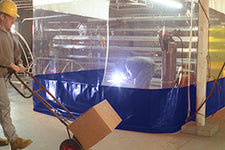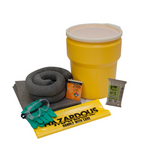Insulated Tarps: Everything You Need to Know About These Tarps
https://pixabay.com/photos/tarpaulin-recycling-3343994/
Insulated tarps are more useful than you think. They can prove to be helpful during bad winters and they contain the heat inside. Not only this, but they’re also used in commercial applications for curing concrete. They’re used in construction projects as well.
Insulated tarps can be used in multiple situations. Warehouses use them for facilitating temperature control. The materials and equipment can be stored at different temperatures, as per the requirement.
Several tarping applications such as refrigerated storage and concrete curing need the usage of insulated tarps. Insulated tarps are useful for keeping out the heat or cold and serving you well in extreme weather conditions.
Warehouses can also use them to wrap an item and protect it from getting damaged.
What Are Insulated Tarps?
https://pixabay.com/photos/construction-tarp-architecture-2810307/
Tarps are pretty thin in width, around 43 mm, and are used as protection against wind and rain. They keep the items and roof dry. An insulated tarp presents all these features but is thicker than this.
Two layers of material, typically polyester canvas encloses a layer of foam cells. These tarps cannot be cut down as per preference otherwise they’re rendered useless.
The materials used
Insulated tarps might differ in terms of the materials the manufacturers have used.
Closed cell foam
This differs from regular cell foam. It helps more in bonding as compared to foam cells.
These foam cells are actually closed off as they don’t let in anything whether it is heat or moisture. This makes them great for insulation.
Open-cell foams are good too but they don’t match the level of closed-cell foam.
Polyester
This is a form of canvas and can be cheaply produced. It's blended with cells having the closed foam property that reflects heat. This makes it a great choice too. Polyesters can easily break down in heat and UV as compared to polyethylene but this doesn’t render it totally ineffective.
These tarps are treated with a chemical to prevent them from breaking down under the sun. Hence, they resist heat on the outside and carry out insulation from the inside.
When Do You Need One?
This depends on the situation. Standard tarps can be used for blocking rainwater. However, insulated tarps fulfill multiple purposes.
Industrial uses
Insulated tarps are widely used in warehouses. This is so because they can help in regulating temperature. Many times, warehouses are not up to par in climate-control, and hence, the equipment inside gets affected by temperature.
Many times, warehouses have a specific temperature. But sometimes, products or equipment require special temperature considerations. It’s also unlikely that all the equipment and material in the warehouse will need to be stored at one temperature. In this case, insulated tarps can come to the rescue and provide long-term solutions.
Outdoor shelters
https://pixabay.com/photos/outdoor-hammock-bushcraft-survival-3681924/
Having an insulated tarp merely as the top of a canopy isn’t going to provide much insulation. Even if you feel warm beneath the tarp, you might still be open to cold air. Therefore, it should also be on each side. To make a fully covered outdoor space, insulated tarps can work pretty well. A space heater can be put inside.
Concrete curing
The size and depth of the project will determine whether it can be wrapped up in days or weeks. It is not done in layers but has to be cured all at once.
The proper way is to insulate in such a way that humidity and moisture don’t affect the curing otherwise the process will take longer.
If you put it over the concrete property, it takes longer to cure but it will also smoothen out the process and there will be no inconsistencies.
Welding
Get protection from high heat and welding with the help of insulated tarps. These tarps provide thermal protection from welding and high-heat applications. They can work against sparks and spatter heat treating and can act as machine covers, as well.
Do insulated tarps cost more?
They’re more costly as compared to a standard poly tarp in a thin grade. A poly tarp with a thickness of 0.006 mm will not maintain any warmth but will certainly keep the rain and wind outside.
While their costs may seem like a downside, insulated tarps are worth the investment. That’s because insulated tarps are on the heavier side. They also have specialized material inside a two-ply tarp. This makes them more long-lasting.
How Long Do Insulated Tarps Last?
Insulated tarps are long-lasting as compared to standard poly tarps. An insulated tarp can last anywhere from five to ten years with UV resistance, maintenance, and proper upkeep. Sometimes, it can last even more than that. Tarps do not last a lifetime but insulated tarps can last for many years, aiding you in industrial uses.
You should also keep inspecting insulated tarps regularly to spot any wear and tear. It can protect the tarps against any potential damage. The following factors affect its longevity too:
Abrasions
If the first piece of the insulated tarp tears off, the closed cells will still function properly. But now, the water can seep in and cause bacterial growth. It can affect the insulation properties of the tarp even if the amount of water is very little. If there are any abrasions on the lining, you can patch them up and put in the appropriate chemical for coating.
Waterproofing
Polyester is waterproof but doesn’t provide the best protection on its own. These kinds of tarps are sprayed with a chemical allowing them to be water-resistant. However, it wears down over a period of time. Once it wears down, you can reapply a waterproofing coat and let it cure. This will restore it to its original shape.
Tears
This creates more of an issue for insulated tarps than standard poly tarps. In the case of a poly tarp, only the outside patching has to be done and it is taken care of. With insulated tarps, you need to inspect the damage, dry it, and make sure that the closed cells are in working condition. Once you have carried out this procedure, carry on with the patching.
So, Are Insulated Tarps a Good Investment?
If you wish to keep the environment at your warehouse or factory temperature-controlled, then insulated tarps are definitely worth the investment. They’re flexible, easy to handle, and easy to install. This makes them the perfect choice for getting safe enclosures. Insulated tarps serve multiple purposes. If you can think of any emergency in which insulated tarps can be used, then do go ahead with it.





























